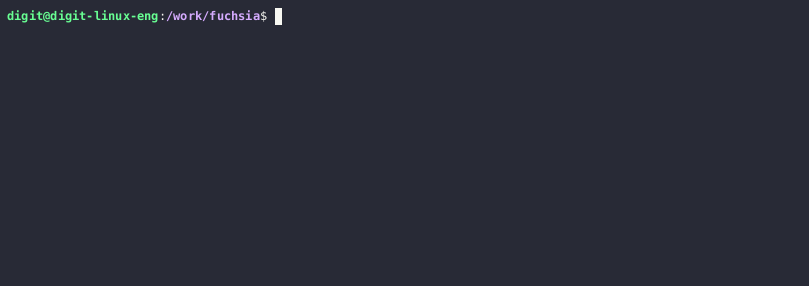The Fuchsia build system uses a custom Ninja binary that provides several improvements to the developer experience. This page describes them.
Motivation
The motivation for customizing Ninja for Fuchsia is detailed in RFC-0153.
In a nutshell, there are a number of features that would benefit Fuchsia developers significantly that are hard to get in the upstream version.
All Fuchsia-specific changes are performed on the local fuchsia-rfc-0153
branch of our local Ninja git mirror, and
are rebased periodically to make them easy to send as GitHub pull requests
to the upstream project, as described in the
Strategy section of the RFC.
Feature: Status of running commands
Set NINJA_STATUS_MAX_COMMANDS in your environment to a strictly positive
integer to let Ninja print, when run in a smart terminal, a table of the
longest running commands, and their elapsed times, just under the status line.
For example, with export NINJA_STATUS_MAX_COMMANDS=4, the status could look
like:
[0/28477](260) STAMP host_x64/obj/tools/configc/configc_sdk_meta_generated_file.stamp
0.4s | STAMP obj/sdk/zircon_sysroot_meta_verify.stamp
0.4s | CXX obj/BUILD_DIR/fidling/gen/sdk/fidl/fuchsia.me...chsia.media/cpp/fuchsia.media_cpp_common.common_types.cc.o
0.4s | CXX obj/BUILD_DIR/fidling/gen/sdk/fidl/fuchsia.me...fuchsia.media/cpp/fuchsia.media_cpp.natural_messaging.cc.o
0.4s | CXX obj/BUILD_DIR/fidling/gen/sdk/fidl/fuchsia.me...dia/cpp/fuchsia.media_cpp_natural_types.natural_types.cc.o
The following animated image shows how this looks in practice:

Note that:
This feature is automatically disabled in dry-run or verbose invocations of Ninja (that is, using the
-nor--verboseflags).This feature is automatically disabled when Ninja is not running in an interactive / smart terminal.
This feature is suspended when running console commands as well (visible in the example above when running Bazel actions).
This feature makes it easy to visualize bottlenecks in the build, that is, long-lasting commands that prevent other commands to run in parallel.
The commands table updates 10 times per second by default, which is very useful
to understand which long commands are hobbling the build. It is possible to
change the refresh period by setting NINJA_STATUS_REFRESH_MILLIS to a decimal
value in milliseconds (not that anything lower than 100 will be ignored since
elapsed times are only printed up to a single decimal fractional digit).
Feature: GNU Make Jobserver support
The GNU Make Jobserver protocol allows a build system to limit the total number of concurrent jobs (i.e. threads or processes) at any point in time, even in the presence of recursive build tool invocations.
It requires a top-level server to setup a pool of job slots that are shared by participating clients (e.g. compiler, linkers, or even build tools).
The Fuchsia-specific Ninja binary can act both as a client or a server for the protocol.
You can enable server mode through the --jobserver command-line flag, or
setting NINJA_JOBSERVER=1 in the environment, when starting Ninja.
When Ninja starts, client mode is enabled automatically by looking at the
value of the MAKEFLAGS environment variable. This is useful when Ninja is
called from a different build that acts as a server.
In the Fuchsia build, setting enable_jobserver = true in args.gn allows the
top-level Ninja invocation to start in server mode.
As an example, it is set for the core IDK and core SDK builder configurations, saving between 6 and 12 minutes of build time. Because these require launching 24+ Ninja sub-builds from the top-level build, which can leverage the protocol to better coordinate how they each spawn multiple parallel commands.
Feature: Generating build traces in Chrome Trace JSON array format
The --chrome_trace FILENAME option can be used to tell Ninja to generate
a trace of build events after the build completes (even in case of failure).
It is recommended to use a .gz suffix in the output FILENAME to
generate a gzip-compressed trace file directly, as these are typically 20 times
smaller.
The file follows the Chrome Trace JSON Array format
and can be loaded directly into the chrome://tracing tab of any
Chromium-based browser, and more interestingly by https://ui.perfetto.dev
which also supports reading compressed traces as input.
Note that the generated trace file also contains flow events that help
visualize the build's critical path. The corresponding build events have
critical_path in the value of their cat field.
Feature: Graceful user-initiated shutdown
When the user presses Ctrl-C to stop the build, Ninja sends SIGINT to its
subprocesses then waits for them to complete, which can take a long time
in certain rare cases.
If the user presses Ctrl-C a second time while waiting, Ninja will now
print a message with a table showing commands that are still running,
and will also send them the SIGTERM signal to gracefully ask them to
stop.
If this is not enough, a third Ctrl-C from the user will send
SIGKILL to all subprocesses to forcefully kill them, and give
back control to the user.
The following animated image shows how this looks in practice:

Feature: Structured logging of failed commands
After a failed build, the .ninja_errors.json file in the build directory
will contain details about each failed action, such as its command, status code
and buffered output (except for Bazel build actions).
This file's JSON schema is described here and can be used by tools and developers to report and reproduce failed actions for debugging.
Feature: Persistent mode for faster startup times
Speed up successive Ninja invocations by setting NINJA_PERSISTENT_MODE=1 in
your environment. This feature makes Ninja launch a background server process
to read the build manifest once, then keep the build graph in memory between
successive builds.
Note that:
This feature should be completely transparent, and should not affect Ninja's behavior otherwise. It you spot an issue or difference, please let us know at
fuchsia-build-team@google.com!Any change in the input
.ninjafile is automatically detected. In this case the existing server will be shutdown, and a new one will be started automatically. No additional user interaction is required after changing a GN build file or performing ajiri update.The server process will shutdown gracefully after idling for 5 minutes. Set
NINJA_PERSISTENT_TIMEOUT_SECONDS=<count>in your environment to change this delay.Use
fx build -t server statusto retrieve the status of the server for the current build directory.Use
fx build -t server stopto stop any running instance of the server explicitly.The server writes log messages to the
.ninja_persistent_logfile in the build directory. Its location can be changed by settingNINJA_PERSISTENT_LOG_FILE=<path>in your environment before starting the server though.Each server process currently takes about 1 GiB of RAM for a
core.x64build configuration. Exact figures will depend on the size of the Ninja graph, which depends on yourargs.gnconfiguration.Each Ninja build directory can be served by at most one server process. But it is possible to have several processes when using several build directories.
Ninja tools (e.g.
ninja -C <dir> -t commands <target>) do not run on the server yet, so will still use slow startup. This will be fixed in the future to speed up queries.
Known bugs / caveats, that will be worked out:
Mixing persistent and non-persistent builds on the same directory can confuse the server at the moment, because independent changes to the Ninja build and deps logs are not properly detected. This will be fixed.
Work-around: use
-t server stopto stop the server before unsettingNINJA_PERSISTENT_MODEin your environment."Fast startup" takes a few seconds. For now, every incremental build still needs to call stat() for all the files in the build graph, which currently takes a few seconds. This will be fixed in the future by using inotify / kqueue based filesystem watching features of the host operating system, to start immediately when only a few files have been modified instead.
Does not work on Windows (yet). This is due to a technical Win32 limitation that prevents copying console handles to other processes. This is mostly an issue for the upstream Ninja team, since Fuchsia development does not happen on Windows.
